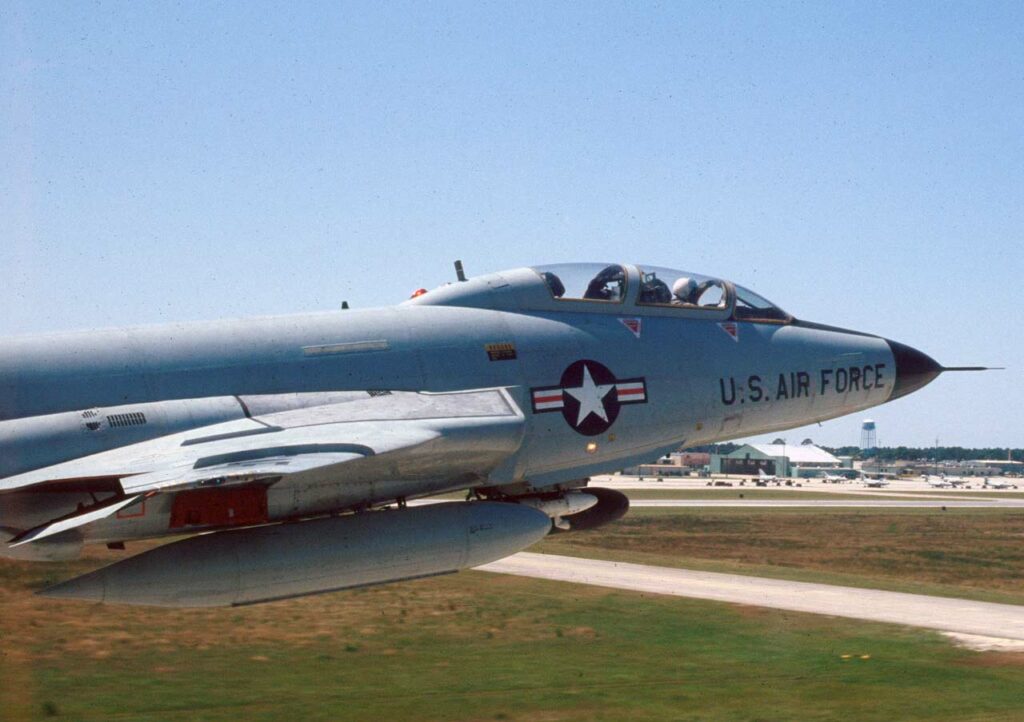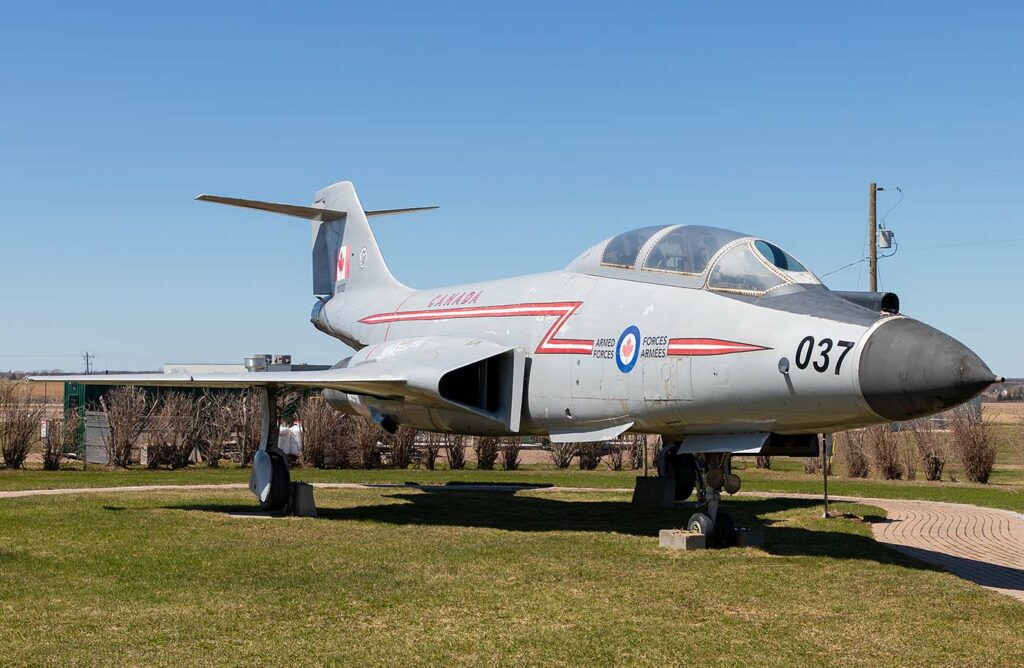McDonnell F-101 Voodoo – A twinjet fighter that served as a reconnaissance aircraft and interceptor, the F-101 Voodoo was a key Cold War asset with Mach 2 capabilities.
Technical Summary
The McDonnell F-101 Voodoo was a pivotal figure in the Cold War aviation landscape, serving primarily in the United States Air Force. Developed by McDonnell Aircraft, it was the first USAF fighter capable of speeds exceeding Mach 1. Initially designed as a long-range bomber escort, its role shifted to reconnaissance and interceptor due to strategic changes. Featuring a twin-engine setup with afterburners, the F-101 boasted impressive speed and altitude capabilities. Its design included a distinctive T-tail, large air intakes, and a swept wing configuration. Operational from the 1950s to the 1970s, it was instrumental in NORAD defense and reconnaissance missions over Cuba during the 1962 Missile Crisis, showcasing its strategic importance.
The McDonnell F-101 Voodoo was a key asset in the Cold War era, marking significant advancements in jet technology and military strategy. It was developed to meet the needs of the United States Air Force (USAF) for a high-speed, high-altitude aircraft capable of multiple roles, including reconnaissance, interception, and nuclear strike missions.

History of the Development of the McDonnell F-101 Voodoo
The story of the F-101 Voodoo begins in the early 1950s, amid the geopolitical tensions of the Cold War. The USAF sought a long-range bomber escort that could accompany strategic bombers deep into Soviet territory. McDonnell Aircraft Corporation’s response to this requirement was the XF-88 Voodoo, which served as the basis for the F-101’s development.
Launched officially by the USAF in the mid-1950s, the F-101 represented a leap forward in aviation technology. It first flew on September 29, 1954, showcasing its potential as a versatile and powerful aircraft. The Voodoo was unique for its time, designed to operate at high speeds and altitudes, challenging the capabilities of contemporary Soviet fighters.
The development of the F-101 was driven by the strategic needs of the era. The USAF required a platform capable of delivering a nuclear payload, performing reconnaissance missions, and intercepting enemy aircraft. The Voodoo’s design evolved to meet these diverse roles, reflecting the changing nature of Cold War military strategy.
McDonnell’s engineers faced numerous challenges during the Voodoo’s development, including achieving stable high-speed flight and integrating advanced avionics and weapons systems. These efforts resulted in a highly capable aircraft, marking a significant advancement in jet fighter design.
The F-101 did not have a NATO nickname, as such designations were typically assigned to Soviet aircraft by NATO members. However, its capabilities and performance earned it a respected place among Cold War aircraft.
Design of the McDonnell F-101 Voodoo
The F-101 Voodoo was a marvel of engineering, characterized by its sleek, aerodynamic design. It featured a length of 67 feet 5 inches (20.55 meters), a wingspan of 39 feet 8 inches (12.09 meters), and a height of 18 feet (5.49 meters), allowing for a maximum takeoff weight of approximately 52,400 pounds (23,769 kilograms).
Its design was optimized for speed and performance, with a swept-wing configuration and a distinctive T-tail that improved stability at high speeds. The Voodoo’s large air intakes were essential for feeding the powerful Pratt & Whitney J57 turbojet engines, which were equipped with afterburners to enhance its speed capabilities.
One of the most significant advantages of the F-101 was its speed, capable of exceeding Mach 2 at altitude. However, this performance came with drawbacks, such as a relatively high landing speed and limited maneuverability compared to later fighters.
The aircraft’s role as a reconnaissance platform and interceptor was facilitated by its advanced radar and avionics systems, enabling it to locate and engage targets at long distances. The Voodoo’s design also included provisions for carrying a variety of weapons, including air-to-air missiles and nuclear bombs, highlighting its versatility.
Performance of the McDonnell F-101 Voodoo
The F-101 Voodoo’s performance was remarkable for its time. Powered by two Pratt & Whitney J57-P-55 turbojets, each producing 16,900 pounds of thrust with afterburner, the aircraft could reach a top speed of over Mach 2 (approximately 1,320 mph or 2,124 km/h) at altitude. It had a service ceiling of 58,400 feet (17,800 meters) and a range of 1,520 miles (2,450 kilometers), extendable with aerial refueling.
Comparing the F-101 to its contemporaries, such as the Soviet MiG-21 and the American F-104 Starfighter, the Voodoo held its own in terms of speed and range. However, its size and weight made it less maneuverable in dogfights, positioning it more as a high-speed interceptor and reconnaissance aircraft than a traditional air superiority fighter.
Variants of the McDonnell F-101 Voodoo
The F-101 Voodoo saw several variants throughout its service life, each tailored for specific roles. The F-101A was the initial fighter-bomber version, followed by the F-101C with improved structural components. The RF-101C was a reconnaissance variant, equipped with cameras for photo intelligence missions.
The F-101B emerged as the primary interceptor version, featuring a two-seat configuration, enhanced radar, and air-to-air missiles. It was complemented by the TF-101B, a trainer variant. The RF-101G and RF-101H served as modified reconnaissance platforms for the Air National Guard.
Each variant of the F-101 Voodoo brought specific enhancements, from increased payload capacities to improved avionics, reflecting the aircraft’s adaptability to evolving military requirements.

Military Use and Combat of the McDonnell F-101 Voodoo
The F-101 Voodoo’s military use spanned various roles, from defending North American airspace as part of NORAD to conducting reconnaissance missions during the Cuban Missile Crisis. Its armament included AIM-4 Falcon missiles and later, the nuclear AIR-2 Genie, underscoring its strategic importance.
The Voodoo saw limited direct combat but was pivotal in reconnaissance, providing crucial intelligence during the Cuban Missile Crisis. Its high-speed capabilities made it difficult for adversaries to intercept, proving invaluable in intelligence-gathering missions.
The F-101 served with distinction in the USAF and was also operated by Canada, playing a key role in NORAD defense. Competing aircraft included the Soviet MiG-21 and the American F-104 Starfighter, each offering different capabilities in terms of speed, range, and maneuverability.
Eventually, the Voodoo was phased out in favor of more advanced aircraft, such as the F-4 Phantom II, which offered greater versatility and performance. Its retirement marked the end of an era for a distinguished member of Cold War aviation history.
The McDonnell F-101 Voodoo stands as a testament to mid-20th-century military aviation, embodying advancements in speed, altitude, and versatility. While it had its limitations, the Voodoo’s contributions to reconnaissance and air defense during a critical period of global tension highlight its significance. Its legacy is reflected in the subsequent generations of aircraft that have built upon its technological foundations.
Back to the Fighter Jet section.